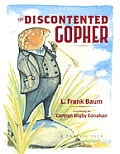The Discontented Gopher in Book Form
 Back in November, I described hearing about a "New Baum Picture Book" called The Discontented Gopher. Having now received a copy of the book, I realize I should recategorize it as a "picture-storybook," that hybrid form that comes up mostly when new authors don't want to cut their picture-book manuscripts. (As in, "But there's something called a 'picture-storybook,' isn't there?" "Yes, but we still need to write very concisely.")
Back in November, I described hearing about a "New Baum Picture Book" called The Discontented Gopher. Having now received a copy of the book, I realize I should recategorize it as a "picture-storybook," that hybrid form that comes up mostly when new authors don't want to cut their picture-book manuscripts. (As in, "But there's something called a 'picture-storybook,' isn't there?" "Yes, but we still need to write very concisely.")
The Discontented Gopher has the complete text of the "animal fairy tale" that L. Frank Baum originally wrote for The Delineator magazine in 1905. The style of his time was more discursive than our post-Hemingway prose, so this book has a lot more text than a typical picture book. This edition is about 7 x 8.5 inches, 32 pages long, with color art on every page spread, printed endpapers, and a nice dust jacket.
The book starts with a three-page introduction on L. Frank Baum's life in Aberdeen, South Dakota, and the struggle between the region's farmers and gophers in the early 1890s. There's no name signed to this introduction, but I suspect it was written by Nancy Tystad Koupal, editor of this series for the South Dakota State Historical Society and also compiler of Baum's Our Landlady columns and the articles in Baum's Road to Oz.
That introduction is quite impressive: it's written at a kid's level yet offers historical background valuable for readers of any age, starting with how the arrival of European farmers in South Dakota changed the environment for gophers and other local fauna. Baum's son Robert was among the many Plains boys who recalled collecting gopher tails for the two-cent bounty, which figures in the story.
The last page of the book is also useful: a glossary of words that appear in Baum's text, some unfamiliar simply because nobody talks like that anymore ("anigh," "smote," "illumined"), and some because he was really writing for mothers and children together ("vainglory," "spasmodic," "tenacity").
In my next posting I'll discuss Baum's text, and after that Carolyn Digby Conahan's illustrations for this edition. Folks wanting to hear more about the genesis of this book can check out KOTA's radio interview with Conahan and Koupal.


No comments:
Post a Comment